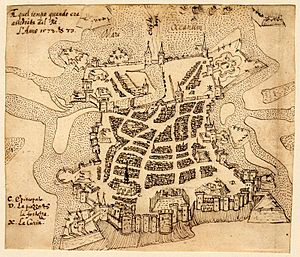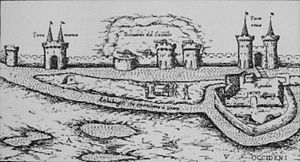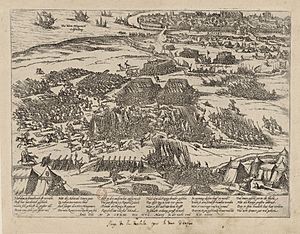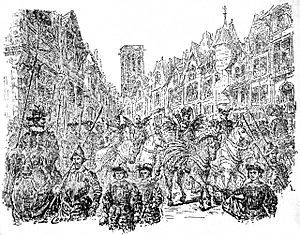Siege of La Rochelle (1572–1573) facts for kids
Quick facts for kids Siege of La Rochelle (1572–1573) |
|||||||
|---|---|---|---|---|---|---|---|
| Part of the French wars of religion | |||||||
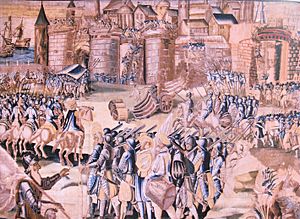 The siege of La Rochelle by the Duke of Anjou in 1573 ("History of Henry III" tapestry, completed in 1623). |
|||||||
|
|||||||
| Belligerents | |||||||
| Commanders and leaders | |||||||
| Strength | |||||||
| Siege army: 28,000. | Defending army: 1,500. Huguenot refugees. |
||||||
| Casualties and losses | |||||||
|
Siege Army: |
Almost entire army and all refugees dead | ||||||
The Siege of La Rochelle in 1572–1573 was a huge military attack on the city of La Rochelle. This city was a stronghold for the Huguenots (French Protestants). Catholic troops led the attack during the fourth part of the French Wars of Religion. This war followed the terrible St. Bartholomew's Day massacre in August 1572.
The conflict started in November 1572. The people of La Rochelle refused to accept Armand de Gontaut, baron de Biron as the king's governor. The siege officially began on February 11, 1573. It was led by the Duke of Anjou, who later became Henry III of France. In May 1573, the Duke was chosen to be the King of Poland. This important news led to talks, and the siege ended on July 6, 1573. The Edict of Boulogne was signed soon after, bringing this part of the civil war to a close.
At the same time, Catholic forces also attacked the cities of Sommières and Sancerre.
Contents
Why Was La Rochelle Attacked?
Since 1568, La Rochelle had been the main base for the Huguenots in France. It was a city of about 20,000 people. It was also a very important port with strong historical ties to England. La Rochelle had a lot of freedom in how it was run. It didn't have a local lord, bishop, or parliament telling it what to do. Because of this freedom, most of its people became Huguenots, following the Calvinist faith.
After the St. Bartholomew's Day massacre in 1572, many Huguenots were killed across France. Many survivors fled to La Rochelle, seeing it as their last safe place. The city was well-protected with strong walls and easy access to the sea.
The Siege Begins
The fighting began in November 1572. The people of La Rochelle would not let Armand de Gontaut, baron de Biron enter as the king's governor. King Charles IX of France then ordered his army to surround the city. In mid-November, François de la Noue was sent by the king to talk with the city. However, the people of La Rochelle asked him to help them defend the city instead.
With the king's permission, La Noue joined the defenders inside La Rochelle. But he could not find a way to end the conflict peacefully. On March 12, 1573, he left the city. He then watched the rest of the siege from the royal army's camp.
On February 11, 1573, the Duke of Anjou arrived to lead the siege. He had a huge army of 28,000 soldiers. They brought massive amounts of supplies, including cannons, gunpowder, and food. These supplies came from many parts of France.
Key Leaders and Challenges
The Duke of Anjou's army included many important people. His brother, François d'Alençon, was there. Also, two former Huguenot leaders, Henry of Navarre and Henri I de Bourbon, prince de Condé, had recently become Catholic and joined the royal side. Members of the powerful Guise family were also present. Many nobles in the royal camp were not fully sure about the king's plans. Some felt bad about the violence of the St. Bartholomew's Day massacre. Others even secretly supported the Protestants. This led to some political disagreements within the royal army.
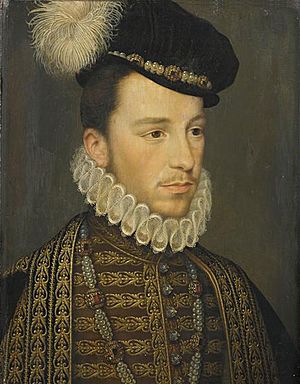
The royal army launched eight major attacks on the city between February and June. These attacks, along with the cold winter, caused many losses for the royal army. One participant, Brantôme, said 22,000 men died. However, records show that out of 155 commanders, 66 were killed and 47 were wounded. On March 26, 1573, 150 attackers died when a mine accidentally exploded. The Duke of Anjou himself was hurt several times during the siege. On May 23, 1573, 6,000 Swiss Guard soldiers arrived to help the royal army. But an attack three days later was a big failure for them.
Seeking Help from England
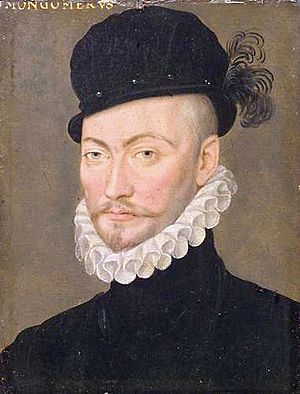
The people inside La Rochelle sent a messenger to Queen Elizabeth I of England. They asked her for help. However, she had signed a peace agreement with France in 1572, called the Treaty of Blois. So, she could only send a small number of ships. These ships were led by Gabriel, comte de Montgomery. Seven ships arrived in February 1573. A larger group of ships tried to come in April but was stopped by the French Navy. They had to turn back.
La Rochelle's supplies were running low. They mostly got what they needed by raiding Catholic ships, especially Spanish ones. Dutch privateers, known as gueux de mer, also attacked these ships. To stop La Rochelle's ships from getting to the sea, the Duke of Nevers tried to sink a large boat. But it didn't work. Later, during another siege in 1627-1628, Cardinal Richelieu built a huge sea barrier to block the city.
At the end of May 1573, the Duke of Anjou received important news. He had been chosen as the new King of Poland. Poland had a group of Protestants, so this made him want to end the attack on La Rochelle quickly. An agreement was made on June 24, 1573. The Catholic troops finally ended the siege on July 6, 1573.
What Happened Next?
The fourth part of the French Wars of Religion ended with the Edict of Boulogne. This agreement was signed in July 1573. La Rochelle was named one of only three cities in France where Protestants were allowed to practice their faith. However, there were strict rules about how they could do so.


